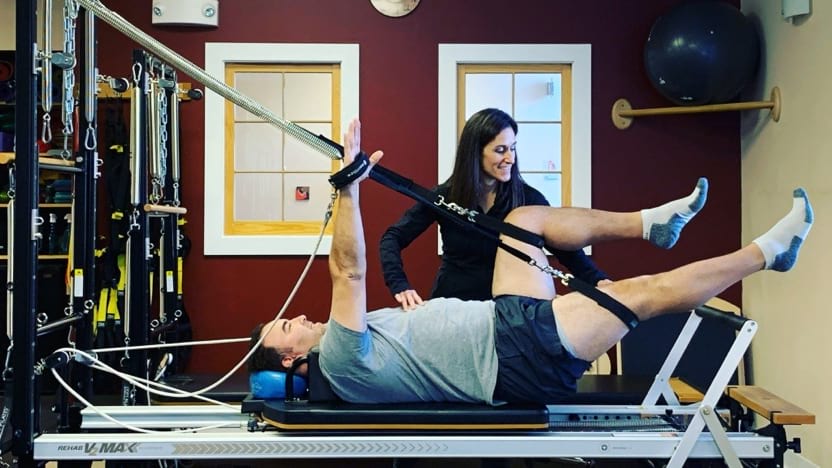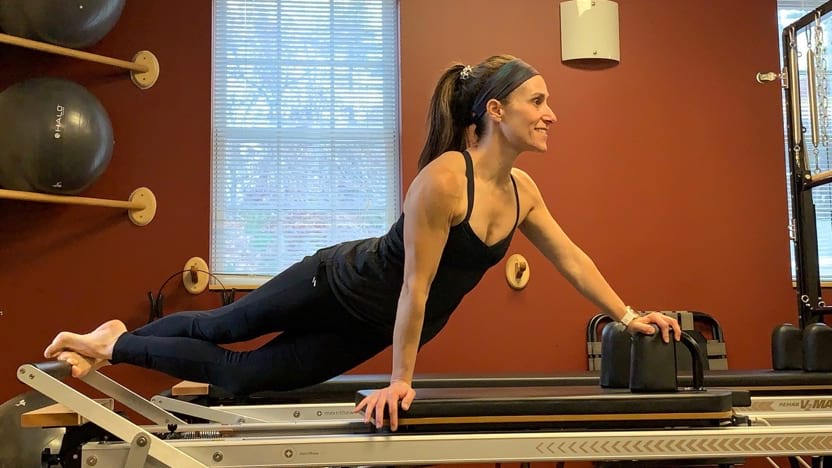
Merrithew® Lead Instructor Trainer and physical therapist Cheryl Cote Alden answers your questions on how to keep your joints healthy and why Pilates is such an effective form of exercise for easing joint pain and stiffness.
Q: Briefly, what is a joint and how does it work?
A: A joint is where two bones in the body meet. They are designed to allow movement at varying degrees depending on where they are located in the body. The joint gains structural integrity by the nature of its design: how the bones ‘fit’ into each other, and from the non-contractile structures like ligaments, capsule, and cartilage that help stabilize the joint. Some joints provide significant mobility but lack stability, like the shoulder joint, while others provide minimal mobility but are more stable like the sacroiliac joint. Some joints are large and built to sustain high loads like the hip joint. Others, like the joints of the cervical spine, are small and are meant to provide mobility but not meant for weight bearing.
Q: Why is Pilates an effective form of exercise for joints?

A: Pilates is an extremely effective form of exercise for joints due to the progressive weight bearing that can be facilitated with the equipment, which can be tailored to meet each individual’s needs and tolerance to exercise. The spring resistance on Pilates equipment can vary to allow for progressive strengthening as tolerated for both the upper and lower extremities as well as the spine. It is low impact strengthening by nature, gentle on joints, but effective to increase strength in a way that does not cause irritation. Pilates can help ease joint pain and joint stiffness by improving mobility, musculature strength of the stabilizers and mobilizers as well as muscular endurance to support the joint.
Movement is beneficial for joint health to maintain and gain mobility, flexibility and strength. A body in motion stays in motion. Pilates provides an effective yet gentle form of exercise to keep all bodies in motion.
Q: Which STOTT PILATES® exercises should people do to keep their joints healthy?
A: Each STOTT PILATES workout should include a variety of exercises to mobilize the joints in the appropriate range of motion, challenge joint stability from multiple directions as appropriate and include exercises that recruit the stabilizers of the joints.
Spinal articulation exercises like Roll Down on the Cadillac or Spine Stretch Forward on the mat help facilitate the small multifidus muscles along the spine. These muscles help provide spinal stability while the movement can also assist in improving spinal mobility.
Challenging balance as one is able is also extremely beneficial for weight bearing joints like the hip and knee. Examples would be Standing Leg Press and Foot Press on the Long Box with the Split-Pedal Stability Chair™. Some of my favorite exercises for lower extremity joint rehab use the Rotational Diskboard™ in a supine or side-lying position on the Reformer. With light resistance, the joint stabilizers are challenged and strengthened without undue joint compression. The large push-pull muscles and global mobilizers need to work, but we can’t forget about all the local and global stabilizers that help support joint motion and stability. A balance of global and local muscle strengthening is what will help keep our joints healthy and mobile.
Q: Do you have any other tips or things you think people should know about their joints?
A: ‘Treat your body like a temple, not a split-level with shag carpeting.’ I read that quote years, perhaps decades ago and it has always stuck with me. We have one body that is extremely intricate and built to last. We sometimes abuse our joints repetitively expecting them to keep going; and when our body inevitably breaks down, we don’t give it the attention it deserves.
So my advice is: Listen to your body. It’s very intuitive. Small issues don’t necessarily have to become big ones if we take the time to treat our joints with care. The absence of pain doesn’t mean an absence of dysfunction. Injuries cause pain but when the pain subsides, a movement dysfunction can remain. We compensate how we move which can eventually lead to breakdown in the same place or somewhere else. Pilates can teach you a lot about your body if you are willing to listen. It can point out imbalances and instabilities that can resolve with consistency and mindfulness in training.
Start your mindful movement journey and discover all the benefits of Pilates with digital workouts and training on Merrithew Connect™ >